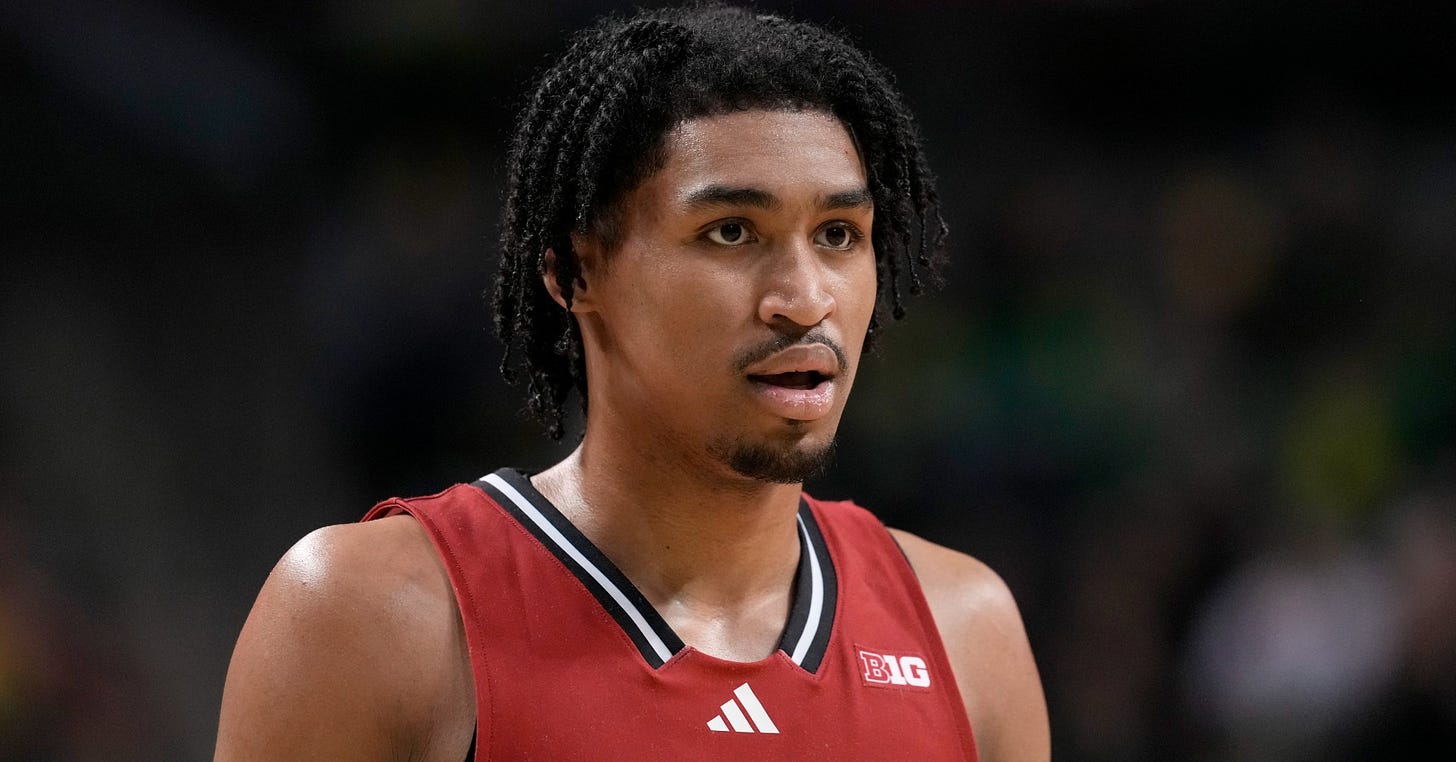You all know the drill by now. This season has not gone well. The Sixers keep their pick for the 2025 NBA Draft if it lands in the top six. Anything after that, and it goes to the OKC Thunder.
Two weeks ago, I wrote about Cooper Flagg, who is as locked in to the No. 1 overall pick as any prospect in recent memory. He’s in the same tier as Wemby in 2023 and Anthony Davis in 2012. There is no debate what the Sixers would do if they win the lottery and get the top pick.
But what of the prospects after Flagg? That’s where the real debate begins for draftniks around the league, and the closest player that’s emerged as a consensus No. 2 is none other than Rutgers’ point guard Dylan Harper.
The son of five-time NBA champion Ron Harper, Dylan is a 6-foot-6 lefty who has long been considered one of the best prospects in this class, and would’ve had a shot at being the first pick had Flagg not skipped a year of high school. Through 27 games, he’s averaged 19.1 points, 4.4 rebounds, and 4.0 assists on 49-34-75 shooting splits for a Rutgers squad that does not have the prettiest record in the world (14-16 overall, 7-12 in conference).
Harper missed three games during the middle of the season, both due to an ankle injury and a nasty case of the flu that reportedly caused him to lose nine pounds. As one might imagine, it took the guard a few games to get back into playing shape after that, as his mid- and late-season numbers are a good tick below what he was doing early in the season. Harper's pinnacle came in November during the Players Era Festival in Las Vegas, when he scored 36 and 37 points in back-to-back nights against Notre Dame and Alabama, respectively.
Harper is a downhill driver who uses his size and strength at the guard position to bully smaller defenders out of the way, and his speed to blow past any bigger bodies matched up against him. Per BartTorvik, Harper has attempted 153 shots at the rim and converted on 69.3% of them while also drawing 5.6 free throw attempts per game. For reference, Tyrese Maxey only averaged 3.9 FTA/G as a college player at Kentucky, while Jared McCain was even lower at 2.4 FTA/G a season ago at Duke, i.e. Harper’s free throw rate is rather impressive for a guard his age. Since he’s a tall, lefty ball handler who wants to live at the rim, you’ll probably see Harper get compared to R.J. Barrett in the coming months, though Harper has shown more promise as a distributor than Barrett had by this point in their respective careers.
His 1.70 assist-to-turnover ratio isn’t anything extraordinary, but it’s well past the Mendoza line of what would be considered a red flag for a lead initiator at the college level. Harper’s passes are more functional than flashy. His tape isn’t littered with no-look dimes or one-handed live dribble passes that go flying to the opposite side. Rather, it’s littered with good reads, where Harper either collapses the defense and makes the easy pass to an open teammate, or capitalizes on an advantage a teammate created and whips the ball to wherever it needs to go next.
Ultimately, the driving and the passing aren’t going to be the questions that determine Harper’s NBA future. He’s plenty good enough at both skills for a 19 year-old guard who is physically built like most wings at the next level. The real on-court attribute to monitor for Harper is whether or not teams are going to respect his jumper.
Going back to his days playing high school hoops at Don Bosco in New Jersey, Harper has often hovered around the 32-35 percent range as a three-point shooter. Good enough that he can’t be ignored from behind the arc, but not elite enough opponents won’t go under screens to take away his drives.
During this season at Rutgers, he’s shot 21-for-55 on catch-and-shoot threes (38.2%) and 26-for-85 on off-the-dribble threes (30.6%) — again, not stellar marks, but also far from disastrous numbers. According to Synergy, he’s 15-for-47 on two-point jumpers (31.2%), which sounds bad on the surface, till you remember how few college players have an established and consistent pull-up mid-range game. The fact that he can even get those shots off with any level of regularity is a plus, even if the accuracy needs work.
Anecdotally, Harper’s pull-ups look better the more control he exerts on the rep itself. The shots where he deliberately attacks a defender’s top foot, then hops back with open space created look a lot cleaner than the reps where he rushes and settles for a pull-up just because his man wasn’t quite up in his air space.
Self-creation is the name of the game for NBA stars, and Harper’s burgeoning step-back craft is a sign that he might hit that level in the future. Compare those jumpers he’s actively creating to the ones where he rushes his footwork and just tries to get a shot up, and the results are night and day.
As strong and as quick as Harper is, he’s not the most vertically explosive prospect in the world. He can be a high quality NBA player on his slashing and distributing abilities alone, but true All-Star level equity down the line will probably be unlocked with a more consistent pull-up jumper, both in the mid-range and behind the three-point line. (Though this is not to say that Harper has a *bad* vertical or poor leaping ability around the rim, he’s just not in the S Tier of bounce).
Now one might be wondering why Rutgers is 14-16 if Harper is a deserving No. 2 overall pick, and one of the players competing with him for that spot is his own teammate Ace Bailey (who is probably getting his own article in the coming months). The most important thing to remember there is that team success at the college level and being a good future NBA player are two distinct things that aren’t always correlated. Anthony Edwards and Toumani Camara were both freshmen on a Georgia team that went 16-16. Before Jalen Johnson became a franchise cornerstone for the Atlanta Hawks, he also played for the only Duke team that missed the NCAA Tournament in the entire 21st century.
What makes Flagg so remarkable is that he’s breaking the age curve of the sport. The best, most productive college basketball player in the country isn’t supposed to be an 18 year-old freshman who might lead his team to a title. More often, freshman stars have seasons that look like Harper’s, filled with ups and downs that are worth inspecting.
Additionally, Harper’s midseason health issues are not something that should just be wiped away. It’s hard to return to the same level of play after losing weight due to something that unpredictable (just look at how Darius Garland’s broken jaw affected him last year). Finally, the reason Harper and Bailey both choosing Rutgers was so notable is that the school doesn’t often have ample NBA talent. The lefty guard was often seeing two defenders sent at him whenever he turned the corner on a ball screen. Defenses committed to getting the ball out of his hands more and more after his red hot start to the season.
Ultimately, the hypothetical decision the Sixers have to make with a pick that lands in the 2-6 range will be difficult. Harper is deservedly the consensus No. 2 prospect in the class, but he’s still a guard with a few questions who’d be going to a team whose two best under-25 players are guards themselves. Defensively, there’s fewer question marks about a Harper-Maxey-McCain fit, because at 6-foot-6, Harper really does have the size necessary to guard up and take on wings at the NBA level (though it’d still be asking quite a lot of a young ball handler to also handle that level of responsibility on the other end of the floor). His 1.4 steals and 0.5 blocks per game are nice, solid marks that indicate a knack for playmaking, but there are few things harder than projecting defensive translation to the next level unless a prospect looks like an absolute world beater on that end in the previous level.
Offensively, the potential fit may appear wonky on the surface. Harper understandably plays on-ball a lot, something Maxey also does quite a bit, and something Sixers fans probably want to see McCain experiment even more with in year two. But think about how basketball has evolved in the NBA the past few years. The OKC Thunder very well might win the title in a few months, and from a distance their overarching philosophy has been “draft every player who can run a pick and roll”. Loading up on creation and ball handling has paid massive dividends for teams like them and the Celtics, and could be the plan moving forward for the Sixers as they head into the late 2020s.
Spend enough time watching any prospect, and you can talk yourself into or out of them with ease. The no-brainer, no-doubt-about-it picks are hard to come by. Harper isn’t so far ahead of the rest of the top prospects that he can be locked in at No. 2 without a second thought, but he’s earned his spot there right now. That height, those handles, and those passing reads are enough to give him a high floor as an NBA talent, and if he can grow on the finer points of his game, he could very well be a home run pick for the Sixers come June.
Daniel Olinger is a writer for the Rights To Ricky Sanchez, and author of “The Danny” column, even though he refuses to be called that in person. He can be followed on X @dan_olinger.
“The Danny” is brought to you by the Official Realtor Of The Process, Adam Ksebe.






